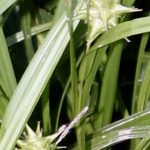
Authored by: Carolyn Aita
Do you want a lush green “lawn” under that black walnut tree where turf will not grow? How about good-looking vegetation to soak up run-off rainwater from the low spot that perpetually floods? Or do you just want a plant with an interesting texture and shape that complements showier plants in your garden? Then a sedge is the right choice for you.
Sedges belong to the botanical group, or genus, Carex. They were the foundation of vast wet meadows that dotted our land before it was drained, plowed, and planted. We can find remnants of these meadows today. Sedges are also found with native companion plants in prairies, under a woodland’s open canopy, on the dry earth under a forest’s closed canopy, and amongst the rocks of rugged cliffs. It is a likely consequence of adapting to many different natural habitats that, as a group, sedges are diverse in appearance. For example, some sedges look like grasses while others look like miniature wetland reeds. Their diversity in appearance and favored habitat makes sedges so valuable as landscape plants. There is a sedge compatible with most garden designs, soil types, and light conditions.
In our gardens, shade-loving sedges masquerading as grass will grow where a lawn is desired but could not thrive, for instance under shallow rooted trees such as maple. Sedges are insensitive to the toxin juglone, and grow under trees in the walnut family. Pennsylvania sedge (Carex pennsylvanica) is grass-like in appearance and forms a dense green carpet that resembles turf when planted beneath black walnut trees. A more flamboyant display is offered by the not-at-all grass-like seersucker sedge (Carex plantaginea), a low-growing plant with broad puckered chartreuse leaves. Seersucker sedge is the showiest of the dry shade sedges and positively glows when planted under trees en masse as a ground cover or singly as bright points amongst other darker-leaved shade lovers.
Sedges that love wet feet are perfect plants for rain gardens for rainwater run-off control on residential properties. These rain gardens can be styled as sedge mini-meadows. At least fifty percent of the plants in a natural sedge meadow are sedge. It is not difficult to build a mini-meadow with a 1:1 ratio of sedges to moisture-loving companion plants. Sedges are clump-forming, they spread slowly by rhizomes (underground stems) and form a matrix within which companion plants thrive. A personal favorite for a rain garden in full to partial sun is bur sedge (Carex grayi) with graceful arching leaves and decorative burs held up proudly on long stiff stems that provide four-season beauty. There are many choices for companion plants, which together with sedge, form a beautiful and robust mini-meadow that support indigenous pollinator insects throughout their flight season.
In the field, sedges are sometimes mistaken for one of their more familiar cousins, grasses or reeds. But most sedges have triangular stems whereas their cousins do not. Any confusion can be settled if we arm ourselves with a hand lens and remember the following well-known rhyme that compares the stems of all three: “Sedges have edges, reeds are round, grasses are hollow, what have you found?”
Carolyn Aita
Master Gardener Volunteer Intern




